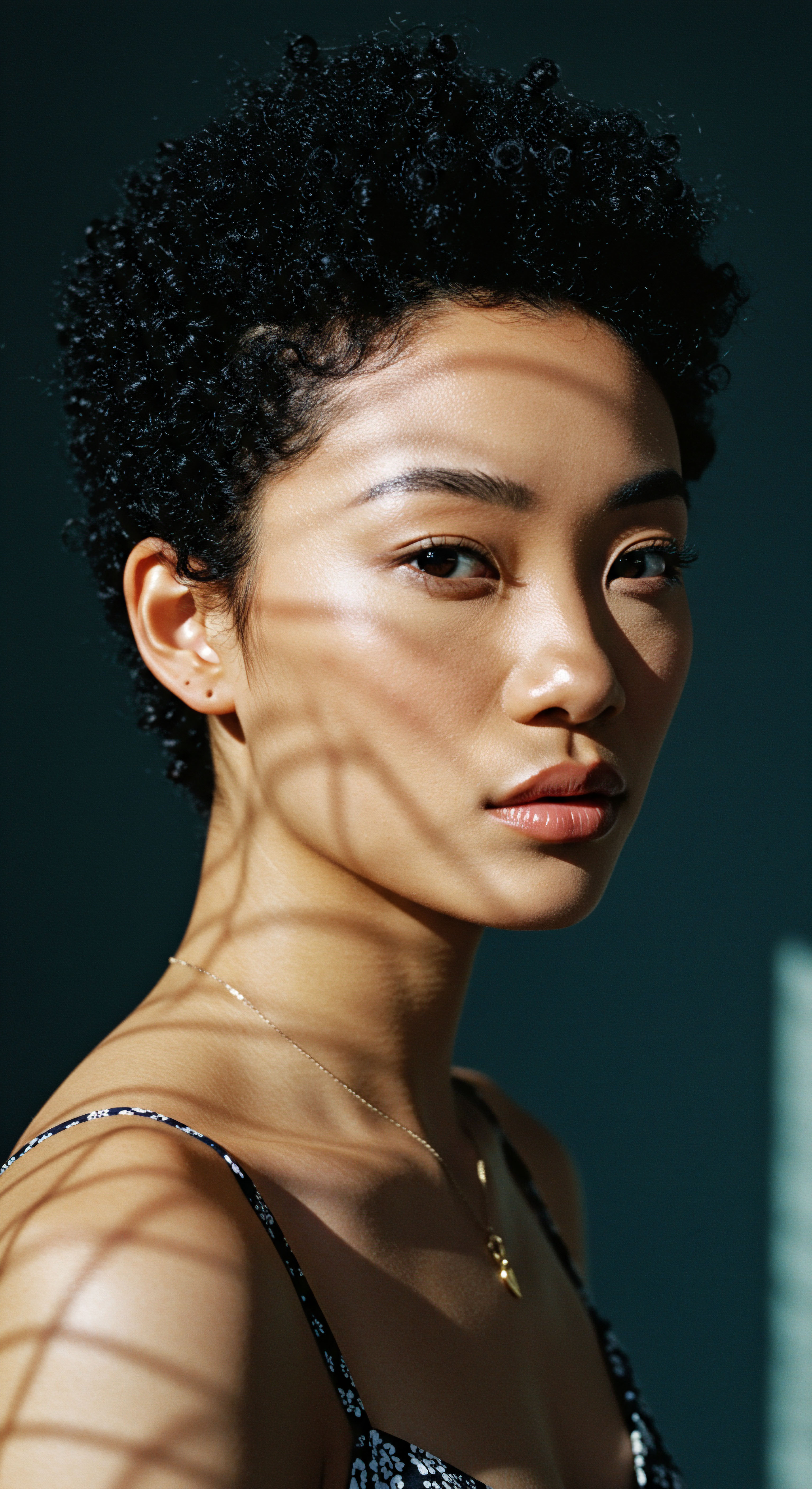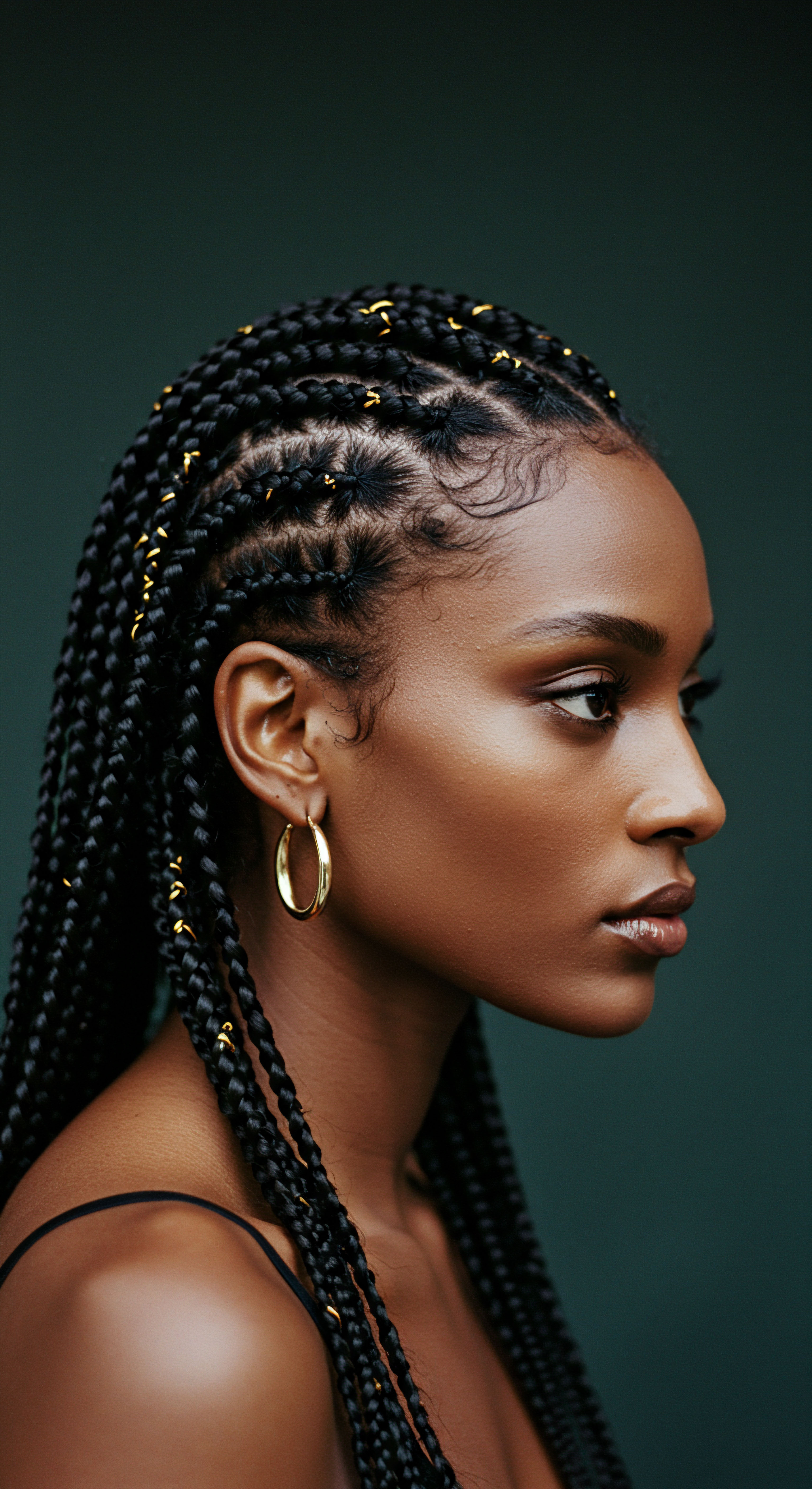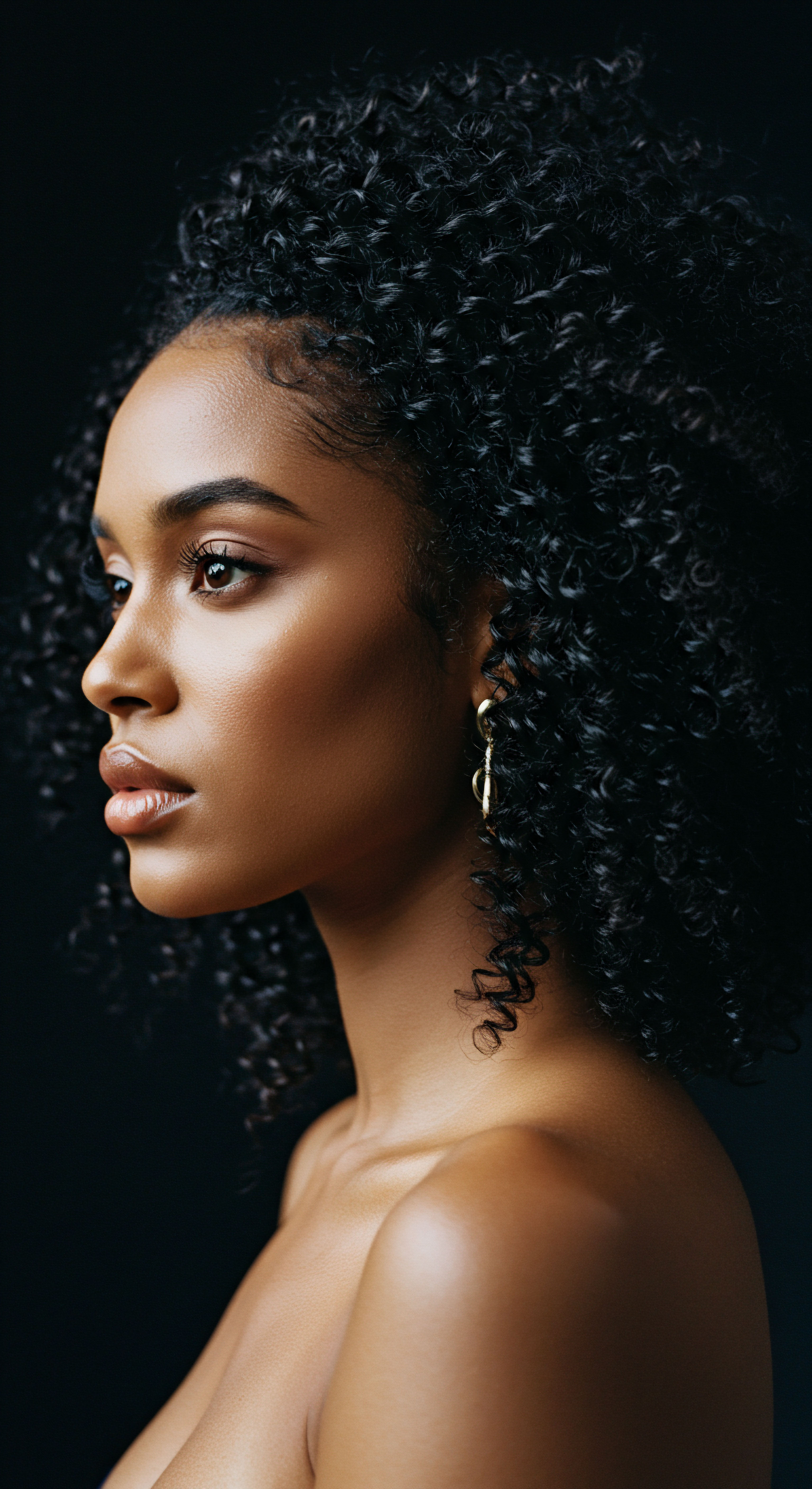
Roots
The quiet hours of night hold a subtle yet profound power over our strands. As the world settles into slumber, our hair, too, enters a state of rest, a period where its very integrity can be either preserved or compromised. This nightly transformation, often overlooked in the rush of daily styling, connects us to an ancient wisdom, a knowledge passed down through generations about safeguarding our crowns during repose. Long before the advent of modern science, communities across the globe intuitively understood the vulnerability of hair as we sleep.
They recognized that friction, tangling, and moisture loss were silent adversaries, capable of diminishing hair’s vibrancy and strength. This deep awareness gave rise to practices that, while appearing simple on the surface, carried layers of ancestral significance, rooted in respect for hair as a living, meaningful extension of self.

What Did Ancient Cultures Do to Protect Hair During Sleep?
Across diverse civilizations, the act of protecting hair during sleep was not merely a cosmetic concern; it was often interwoven with cultural identity, spiritual belief, and practical necessity. In ancient Egypt, for instance, elaborate hairstyles and wigs were symbols of status and beauty. To preserve these intricate creations, wealthy Egyptians often utilized specialized headrests, crafted from materials like stone or wood, which elevated the head and neck, keeping hair suspended and undisturbed throughout the night.
This practice minimized friction and prevented the crushing of carefully styled hair, ensuring its pristine appearance for the following day. The ingenuity behind these headrests speaks to a sophisticated understanding of hair’s fragility and the value placed upon its presentation.
Similarly, in many African communities, head coverings, such as headwraps, have served for centuries as a means of protection from the elements and a way to maintain hairstyles. While these were often worn during the day, their protective qualities naturally extended into the night. The careful wrapping of hair before sleep was a practical measure to guard against friction, dust, and environmental stressors, preserving moisture and preventing tangles. This practice became particularly vital for textured hair, which is more prone to dryness and breakage.
Ancestral practices of hair protection during sleep, like ancient Egyptian headrests and African headwraps, demonstrate a timeless understanding of hair’s vulnerability and cultural significance.
Beyond simple preservation, these nighttime rituals often held deeper cultural meaning. Hair was, and remains, a powerful symbol in many African societies, conveying status, age, marital standing, and even spiritual connections. To protect one’s hair was, in essence, to protect one’s identity and connection to community. The care given to hair at night was a quiet act of self-reverence, a continuity of daily rituals that honored the hair’s sacred place.

The Early Science of Hair and Rest
Even without microscopes or chemical analyses, ancient peoples observed the effects of sleep on hair. They recognized that unrestrained hair could become matted, tangled, and dull by morning. This observational knowledge, passed down orally and through practice, formed the bedrock of their hair care regimens.
The understanding that hair is more susceptible to damage when wet, for example, was likely an early discovery. While modern science confirms that wet hair has raised cuticles and weaker hydrogen bonds, making it more prone to breakage, ancient communities probably noticed the tangible results of sleeping on damp strands.
- Wet Hair Vulnerability ❉ When hair is wet, its outer cuticle layer lifts, making it more susceptible to physical friction and stretching.
- Friction Damage ❉ Rubbing against rough surfaces, like cotton pillowcases, causes tangles, frizz, and breakage.
- Moisture Loss ❉ Absorbent fabrics can draw essential moisture from hair, leading to dryness and brittleness.
The choice of sleeping surfaces also played a role. While not always explicitly documented, the preference for smoother materials, or the use of head coverings made from finer fabrics, would have been an intuitive response to the adverse effects of friction. The development of headrests, for instance, served to minimize contact between hair and rough sleeping surfaces altogether. These early forms of hair protection during sleep, born from keen observation and cultural reverence, laid the groundwork for the modern practices we uphold today.

Ritual
As daylight fades and the rhythm of life slows, a quiet transformation begins. The shift from day to night calls for a different kind of attention, particularly for our hair. This “Ritual” section acknowledges that our hair, like our bodies, deserves a gentle, mindful transition into rest.
It invites a deeper look into the practical wisdom that has shaped nighttime hair care, moving beyond simple habits to explore the intentional practices that preserve hair’s vitality. These are not just steps; they are purposeful actions, each carrying a whisper of continuity from those who cared for their crowns long before us.

Why Nighttime Care Is a Legacy Practice
The consistent practice of protecting hair at night, particularly within Black and textured hair communities, stands as a testament to resilience and self-preservation. Historically, and continuing today, these routines extend the life of styles, reduce daily manipulation, and maintain moisture balance. For textured hair, which is inherently more prone to dryness and mechanical damage, nighttime care is not a luxury but a fundamental component of health.
The cultural continuity of these rituals is striking. Many Black women today speak of learning to wrap their hair or wear a bonnet from their mothers and grandmothers, a practice passed down as a quiet act of self-love and hair wisdom. This lineage speaks to a deep understanding of hair’s unique needs and the importance of its preservation. The materials and methods may have evolved, but the underlying purpose remains steadfast ❉ to shield strands from the rigors of sleep, ensuring they awaken refreshed and ready for the day.
| Method Headwraps and Bonnets |
| Ancestral Context Used for protection from elements, status, and preserving styles in African cultures. |
| Modern Application Commonly used by Black women to prevent friction, retain moisture, and maintain styles. |
| Method Smoother Surfaces |
| Ancestral Context Ancient Egyptian headrests minimized hair contact with rough surfaces. |
| Modern Application Silk or satin pillowcases reduce friction and moisture absorption. |
| Method Protective Styling |
| Ancestral Context Braiding and twisting for preservation in African and Caribbean cultures. |
| Modern Application Loose braids, twists, or "pineapple" styles prevent tangling and crushing. |

What Is the Science Behind Nighttime Hair Protection?
The seemingly simple act of covering hair or sleeping on a particular fabric is backed by tangible scientific principles. The primary aggressor during sleep is Friction. As an individual shifts position, hair rubs against the sleeping surface and against itself.
This mechanical stress can lift the hair’s cuticle, the outermost protective layer, leaving the inner cortex vulnerable. When the cuticle is raised or damaged, hair becomes more prone to frizz, tangling, and ultimately, breakage and split ends.
A study on hair friction, for instance, highlighted how mechanical force from combing and contact with various materials can wear down the hair cuticle. Given that an average person shifts position up to 40 times per night, the repeated friction between hair and a pillowcase, combined with the weight of the head, creates significant opportunity for damage. This is particularly relevant for curly or textured hair, which has more points of contact and is naturally more susceptible to friction.
Beyond friction, Moisture Retention plays a critical part. Cotton pillowcases, despite their comfort, are highly absorbent. They can draw moisture and natural oils away from the hair, leading to dryness, dullness, and increased frizz.
Silk and satin, conversely, possess a smoother surface and are less absorbent, allowing hair to glide without snagging and helping to keep its natural hydration intact. This difference in material properties directly translates to healthier hair over time.
The smooth surfaces of silk or satin minimize friction and moisture loss, crucial factors in preserving hair health during nightly rest.
Consider a practical example ❉ a 2018 article in Women’s Health, citing celebrity hairstylist Andre Walker, noted that “Standard cotton cases are known to cause breakage and split ends,” because cotton is an absorbent fabric that “can sap your hair of moisture.” In contrast, “Silk pillowcases help to maintain your style, in addition to keeping your curls and coils from frizzing and straightening out,” due to less friction. This widely observed difference underscores the practical benefits of choosing appropriate sleep surfaces.

How Can We Create a Mindful Nighttime Ritual?
Crafting a nighttime hair care ritual involves thoughtful choices that honor both ancestral wisdom and scientific understanding.
- Selecting the Right Surface ❉ Opt for Silk or Satin Pillowcases or bonnets. These materials significantly reduce friction and help retain hair’s natural moisture, minimizing tangles, frizz, and breakage.
- Choosing a Protective Style ❉ Before bed, consider gathering hair into loose styles. A Loose Braid, a gentle twist, or the “pineapple” method (gathering hair at the crown) can prevent crushing and tangling, especially for longer or textured hair.
- Ensuring Dryness ❉ Hair is most vulnerable when wet. Allowing hair to dry completely before sleep prevents the cuticle from swelling and becoming more susceptible to damage from friction.
These practices, whether passed down through family stories or discovered through personal research, form a bridge between past wisdom and present needs. They represent a deliberate act of care, ensuring that the hair, a symbol of identity and beauty, is shielded through the quiet hours, ready to greet the new day with vitality.

Relay
Stepping into the deeper currents of hair protection during sleep, we find ourselves at a crossroads where biology, history, and cultural meaning converge. This “Relay” section seeks to illuminate the profound interconnectedness of these elements, moving beyond the obvious to uncover the subtle yet powerful ways ancestral practices continue to shape our understanding. It is an invitation to witness how scientific discovery often echoes ancient observations, and how the preservation of hair at night becomes a powerful act of continuity, a silent conversation across generations.

How Do Biological Realities Align with Ancestral Practices?
The biological structure of hair, particularly textured hair, provides a compelling scientific rationale for the ancestral practices of nighttime protection. Textured hair, with its unique curl patterns, possesses an elliptical or flattened cross-section, leading to more points of contact along the hair shaft compared to straight hair. This structural difference makes it inherently more prone to tangling and breakage when subjected to mechanical stress, such as rubbing against a pillow during sleep. The cuticle, the protective outer layer of each hair strand, is also more exposed at the curves of a coil, making these areas particularly susceptible to damage from friction.
Ancestral practices, though not articulated in scientific terms, directly addressed these biological vulnerabilities. The use of head coverings, like bonnets and headwraps, effectively creates a smooth, contained environment for the hair, minimizing contact with abrasive surfaces. This acts as a physical barrier against friction, preserving the cuticle’s integrity and reducing the likelihood of breakage.
Similarly, the practice of braiding or twisting hair before sleep, common in many African and diasporic cultures, reduces the surface area exposed to friction and prevents individual strands from snagging on one another. This containment strategy directly counters the natural tendency of textured hair to tangle and form knots during restless sleep.
Furthermore, textured hair tends to be drier than straight hair due to the natural oils from the scalp having a more challenging path to travel down the coiled shaft. This dryness makes it more brittle and susceptible to damage. Materials like silk and satin, traditionally used for head coverings or sleeping surfaces, are less absorbent than cotton.
This property helps to retain the hair’s natural moisture and applied products, directly supporting the hair’s hydration needs overnight. The ancestral wisdom of selecting these materials, or adopting practices that minimize moisture loss, finds strong validation in modern hair science.

What Is the Cultural Weight of Nighttime Hair Rituals in the Diaspora?
The cultural significance of hair protection during sleep extends far beyond mere physical preservation, particularly within the African diaspora. It is a profound act of cultural continuity and self-affirmation, carrying echoes of both historical oppression and triumphant resilience. During periods of enslavement, African women were often stripped of their traditional hair styling tools and practices, and their hair was frequently shorn or forced into styles that erased their cultural identity. Laws like the Tignon Law in Louisiana, for instance, mandated that free Black women wear headwraps to signify their lower social status.
Yet, even under such oppressive conditions, head coverings became a powerful symbol of resistance and creative expression. Women transformed mandated headwraps into statements of dignity, using vibrant fabrics and elaborate styles. This spirit of reclaiming and transforming symbols of control continues to resonate in modern nighttime hair practices.
The bonnet, often seen as a simple sleep accessory, carries centuries of this resilience and cultural excellence. It is a tool for preserving hair, but also a quiet act of defiance against historical attempts to diminish Black identity.
Nighttime hair rituals, particularly in the African diaspora, embody a deep cultural legacy of resilience, self-care, and the preservation of identity against historical adversity.
The ritual of wrapping hair or donning a bonnet before bed becomes a private moment of self-care, a quiet connection to ancestral practices that prioritized hair health and cultural pride. It is a practice that speaks to an understanding that caring for one’s hair is caring for one’s self, a deeply personal and often collective experience. This connection to heritage is not always overtly spoken, but it is felt in the consistent, loving attention given to hair each night.

Can Sleep Position Influence Hair Health?
Beyond materials and styles, the very position of sleep can play a role in hair health, a detail often observed by individuals with sensitive hair. While not a universally acknowledged ancestral practice in the same way as head coverings, anecdotal evidence and modern recommendations suggest that certain sleep positions can minimize mechanical stress on hair. For those with curly or textured hair, sleeping on one’s back can flatten curls and create frizz due to the constant rubbing against the pillow.
Sleeping on one’s side or stomach, if comfortable, can reduce direct pressure on the hair follicles and minimize matting. The aim is to reduce the direct crushing and friction that occurs when the full weight of the head rests on the hair. While no ancient texts prescribe specific sleep positions for hair, the overarching ancestral goal of preserving hair’s integrity would naturally align with any adjustments that minimize damage. This subtle awareness of how movement during sleep impacts hair demonstrates an intuitive understanding of physical mechanics, even if not formally codified.
A 2014 study by Bhushan et al. “Friction Dynamics of Straight, Curly, and Wavy Hair,” found that curly hair, with its increased points of contact, is more prone to friction damage. This scientific finding supports the intuitive understanding that minimizing contact and movement during sleep is beneficial for preserving textured hair. This research provides a modern, data-backed perspective on observations that have likely guided protective practices for centuries.

Reflection
The quiet commitment to protecting our hair during sleep, whether through a silk bonnet, a carefully placed pineapple, or the memory of a grandmother’s headwrap, speaks to something deeply rooted within us. It is a practice that transcends mere aesthetics, connecting us to a lineage of wisdom that understood hair as more than strands; it is a living crown, a cultural marker, a personal statement. As we drift into the night, the simple acts of care become a silent dialogue with the past, a continuation of a legacy that honors every coil, curl, and wave.

References
- Healthline. How to Sleep with Curly Hair ❉ 5 Tips and Tricks. 2020.
- Helix Hair Labs. The History of the Hair Bonnet. 2023.
- Byrdie. The Significance and History of Bonnets. 2022.
- Cee Cee’s Closet NYC. The History of Bonnets. 2021.
- Wilderness Safaris. The History & Meaning of Head Wraps Across Africa. 2015.
- The History and Evolution of Hair Bonnets ❉ From Traditional to Modern Styles. 2024.
- Hairports Miami. Sleeping With Wet Hair ❉ How It Causes Breakage.
- Reddit. What’s worse, going to bed with wet hair or using heat to dry it? ❉ r/HaircareScience. 2023.
- Is your lack of sleep causing hair loss?
- Be Inspired Salon. How to Protect Your Hair While Sleeping.
- HairKnowHow.Com. High Porosity Hair ❉ What It Means For Your Hair.
- Sleep.com. How a Hair Wrap Routine Protects More Than Just My Hair. 2021.
- YouTube. The History of Headwraps | Crowned | Byrdie #SHORTS. 2022.
- Hair Care Practices from the Diaspora ❉ A Look at Africa, America, and Europe. 2025.
- Reddit. What’s the science behind trying to take care of your damaged hair? ❉ r/HaircareScience. 2023.
- Slipssy’s First-Night Effect ❉ How Reducing Friction Transforms Your Hair Overnight. 2025.
- Lab Muffin Beauty Science. Silk for Skincare and Haircare. 2020.
- Obé Headwear. Significance of headwraps | Hair care. 2024.
- RevAir. Repair Your Hair While You Sleep. 2022.
- Little Extra. How to Prevent Split Ends While Sleeping. 2023.
- Ancestral Stiles ❉ Caribbean Abolitionist Home Practices.
- TikTok. African Ancestors Hair Routine. 2025.
- GirlsOnTops. A Sacred Legacy ❉ On Black Hair And The Revolutionary Power of Self-Exp. 2020.
- Clinikally. 10 Effective Ways to Protect Your Hair While You Sleep. 2023.
- Lady & the Hair Salon. How to Sleep with Curly Hair ❉ 7 Expert Tips. 2024.
- VIORI Shampoo Bars. 5 Hair Rituals From Around the Globe. 2022.
- African Pride. 8 Ways to Protect Your Natural Hair at Night.
- Women’s Health. ‘I Slept On A Silk Pillowcase For 2 Weeks—Here’s What Happened’. 2018.